This guide assumes you have a
Linksys BEFSR41 router. It will be fairly similar if
you have another Linksys router like the 'wireless' or 'firewall'
(BEFSX41) version but I'm not sure because I don't have
these.
I'm running Windows XP Pro, but these instructions work
fine with XP Home too. Windows98 users will want to look
at the alternate
instructions. The first two alternatives describe
how to configure the router without using DHCP. Using
DHCP sometimes makes things messy but Linksys offers a
way to keep DHCP via Port
Triggering
The aim of the guide is to show you how to setup your
Linksys router so that you can use eMule. There are two
ways to do this, either as below using UPnP, or by using
a browser. These instructions are long and drawn out on
purpose, hopefully so you don't get stuck! Realistically
the whole thing is really very easy once you get the
hang of it, so please don't be too intimidated by how
long these instructions are.
Windows XP UPnP instructions
- The first step is to make sure you have a fairly
recent firmware version for your router. Firmware is
like the internal software inside the router. You
can upgrade to the latest version by visiting
the Linksys download page. Select your router
from the drop down list, select the firmware link,
save the file and follow the instructions. They make
it fairly easy and straightforward to do, and it is
quick.
- Once you've done the previous step... In
Windows, click start>settings>control panel>network
connections to open this page:
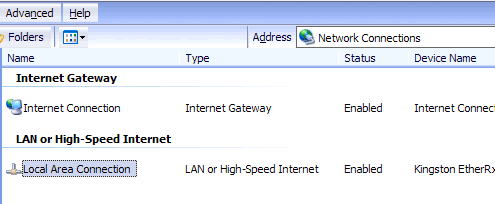
Compare what you see to my picture, if you have the
entry that says Internet Gateway enabled, you
already have UPnP installed and this whole process
will be easier. Windows XP should have already set
all this up if you bought your router and it already
had firmware version 1.42 (?) or later installed. If
you do anyway then skip ahead to
step number 4 below.
- To install UPnP:
- Click Start, click Control Panel, and then
click Add or Remove Programs.
- In the Add or Remove Programs dialog box,
click Add/Remove Windows Components.
-
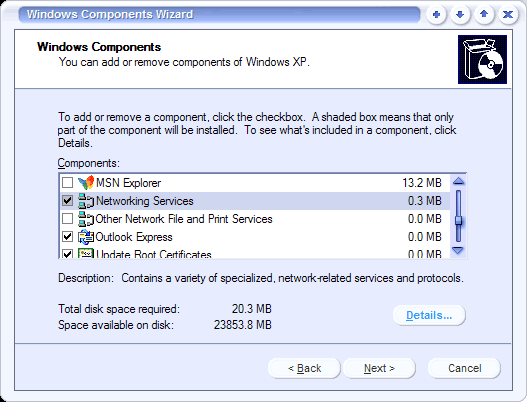
In the Windows Components Wizard, click
Networking Services, click Details, and then
select the 'Universal Plug and Play' check box.
You should also see 'Internet Gateway Device
Discovery and Control Client' listed, put a tick
in the check box for this also - as I've done
below.
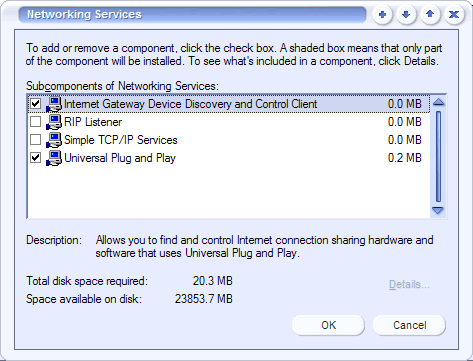
- Click OK, and then click Next in the Windows
Components Wizard. You may need to provide your
Windows XP installation CD.
( I found this info at
http://www.microsoft.com/windowsxp/expertzone/columns/crawford/02july22.asp)
- Using your browser, go to
http://192.168.1.1/Passwd.htm and, as shown
in the picture below, make sure that 'UPnP
Services' are enabled:
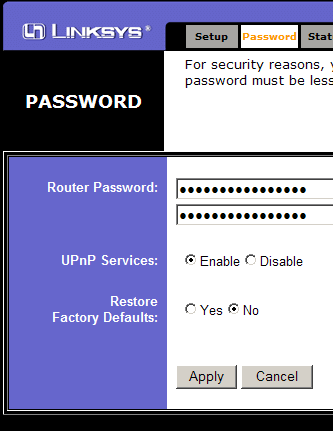
- Click Start>Settings>Network Connections.
Right click on 'Local Area Connection'. Select
'Properties'. A small window appears. At the top
click on 'Advanced'. Make sure that the XP
firewall is turned off as in the picture below:
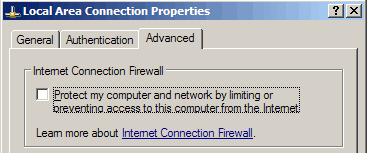
- Now check back to step 2 above to make sure
you have the UPnP working right. It seems to
take a while for the internet gateway entry to
appear so be patient, wait a couple of minutes
perhaps and check again if it isn't showing when
you first look, refreshing the window often
makes it miraculously appear.
- Now that you have UPnP up and running setting up
port forwarding is really quite simple...
The first thing to do is to highlight the entry for
the local area connection in the network connections
page just like i'm doing in the picture below:

On the left side in the details section you should
now see your router assigned ip address as shown in
the picture below:
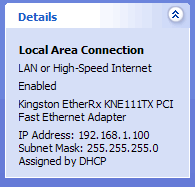 ...in
this example it is 192.168.1.100, make a mental note
of whatever yours happens to be. ...in
this example it is 192.168.1.100, make a mental note
of whatever yours happens to be.
- Back on the main section of the page, right
click on 'Internet Connection' and then select
'Properties' from the menu that appears.
You'll see this window:
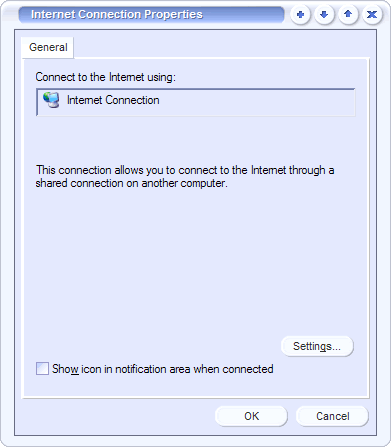
Click on settings, and then 'Add'. This is where you
will specify which ports the router needs to forward
to make eMule work. Fill in the blanks as below,
except in the IP address field substitute your own
router assigned IP address that you memorized from
the previous step. The 'Description of Service' text
field can be anything you like - it's just so you
can identify it later... "eMule" works just fine:
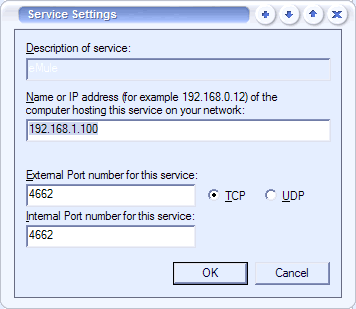
- After clicking on 'OK' to save this new setting,
click 'Add' once again to setup a second port
forward. Once again fill in your own IP address,
type "eMule" as the description of service, and copy
the remaining details as they are shown below. Then
click 'Ok' to save the settings:
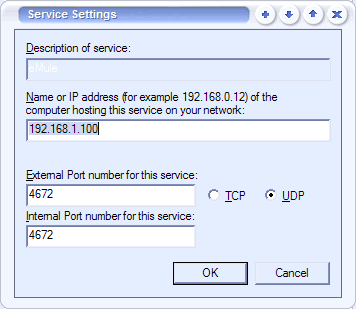
- You'll notice that you now have two entries for
eMule, as in the picture below:
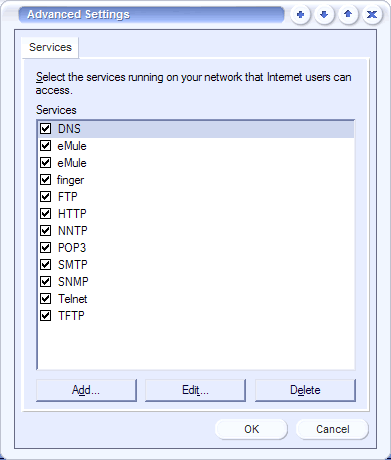
Click 'Ok' to save the settings you made and exit.
That's pretty much all there is to it! You've told
your router to forward incoming traffic to ports
4662 and 4672 on your computer. Run emule and
everything should now work.
There's another way of doing all this.
- Open up your web browser and type in the
address: http://192.168.1.1 to access your router
status pages. Enter your password, the username is
an empty field on my machine and it doesn't seem to
matter... you HAVE changed the default password
right? If not then for your own sake read your
linksys manual and do this now!
- Click on the DHCP tab at the top

Then click on the button labelled 'DHCP Clients
Table'. You'll see the window below appear:

Look in the Client Hostname column, find your
computer name and memorize the last three numbers of
the IP address to the right of it. In this example
the client hostname is 'Christopher', and the last
three numbers of the IP address are 100. Once you've
got those three numbers memorized then close the
window.
- At the top of the screen, on the right hand
side, click on the orange colored tab labelled
'Advanced'. You'll arrive on the 'filters' page -
you don't want to do anything here, instead click on
the second tab along labelled 'Forwarding'... and
fill out the details as I have below. Except of
course you need to fill out the last three numbers
of your IP address that you memorized (it might well
be 100 like mine is):

- At the bottom click on 'Apply' to save the
settings you just typed in. Now your router is setup
to forward incoming traffic to ports 4662, and 4672
on your computer. Close out the browser window, and
run eMule, it should now work!
Configuration with DHCP via Port
Triggering
- Open up your internet browser and type the
IP Address of your router (default:
192.168.1.1). Enter in your password
(default: admin - change it!). Click
'Advanced'. Click 'Forwarding'.
- In the Forwarding screen you will find the
button Port Triggering. Click it and
enter the configuration shown below. You can
ignore the msn entry when configuring eMule.
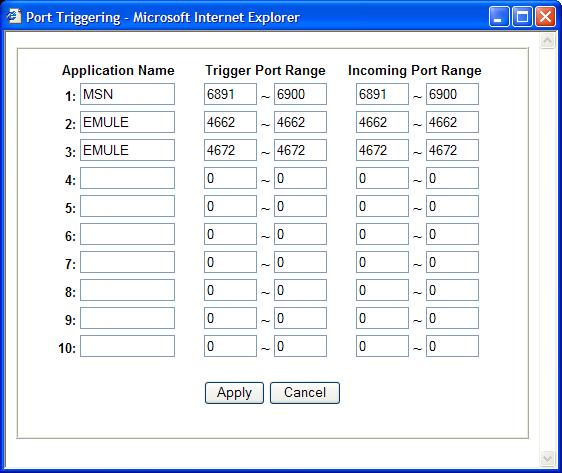
- Press 'Apply'.This should now allow
your router to forward eMule packets to your
machine without the need for specific IP
Addresses allowing for DHCP or multiple machines
using eMule.
|
|
|






















![]()